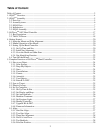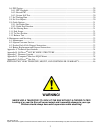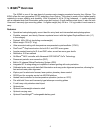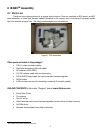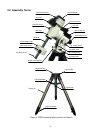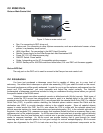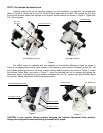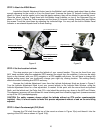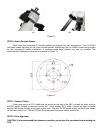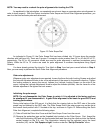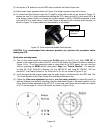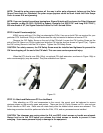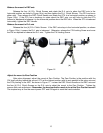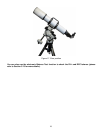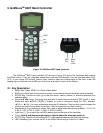
10
STEP 3. Attach the iEQ45 Mount
Locate the Azimuth Adjustment Knobs (next to the Bubble Level Indicator) and retract them to allow
enough clearance for the mount to fit on the tripod head. Unscrew the three (3) Azimuth Locking Screws
shown in Figure 8 and be careful not to lose the plastic washers; they will be needed to secure the mount.
Place the mount onto the Tripod Head with the Bubble Level Indicator on top of the Alignment Peg as
shown in Figure 9. Place the Teflon washers and the three (3) Azimuth Locking Screws back and tighten
the screws. Level the tripod base by adjusting the individual legs. You may use the built-in Bubble Level
Indicator or an external torpedo level to check leveling.
Azi. Adjust. Knob
Bubble Level Indicator
Azi. Locking Screw (3)
Plastic Washer
Lat. Mark Window
Lat. Locking Screw (4)
Figure 8
Alignment Peg
Figure 9
STEP 4. Set the Location Latitude
This step requires you to know the latitude of your current location. This can be found from your
8407 hand controller after the embedded GPS receives the signal from the satellites. It also can be easily
found on the Internet, with your GPS navigator or a GPS capable cell phone. You will have to change this
latitude setting every time you significantly change your night sky viewing location. This setting directly
affects the mount’s tracking and GOTO accuracy.
Unscrew the Latitude Adjustment Lever from the Latitude Adjustment Knob as shown in Figure 6.
Turn the Latitude Adjustment Knob to set your current latitude in the Latitude Mark Window, using the
Latitude Adjustment Lever for a fine adjustment, if needed. At this point, with the mount level and pointed
North, and the latitude set, the Polar Axis (R.A. axis) should be pointing very close to the NCP and Polaris.
This alignment accuracy will be sufficient for visual tracking and short duration piggy-back (camera mounted
on top of the OTA) astrophotography.
CAUTION: For safety reasons, always adjust the latitude without an OTA and/or counterweights
installed. Also, it is much easier to make this precise adjustment without a load on the axis being
adjusted.
STEP 5. Attach Counterweight (CW) Shaft
Unscrew the CW shaft from the top of the mount as shown in Figure 10(a) and thread it into the
opening of the DEC axis as shown in Figure 10(b).



